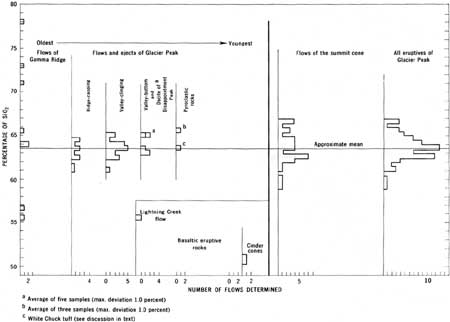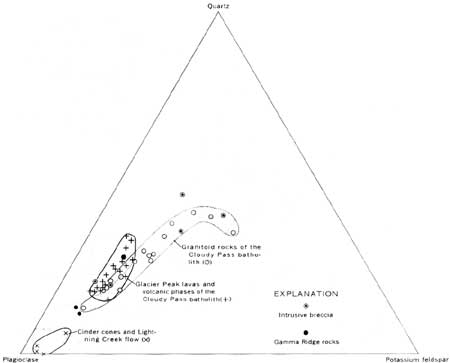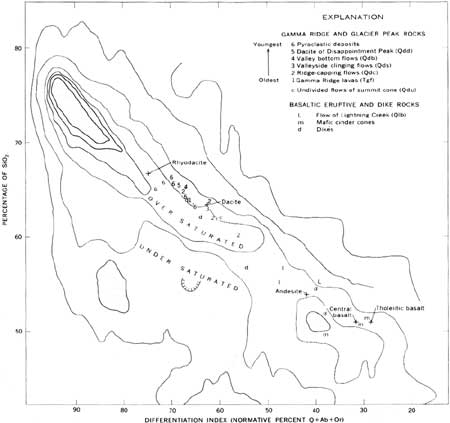
|
Geological Survey Professional Paper 604
On Batholiths and Volcanoes—Intrusion and Eruption of Late Cenozoic Magmas in the Glacier Peak Area, North Cascades, Washington |
LATE EPISODE OF VOLCANISM: GLACIER PEAK VOLCANO AND ASSOCIATED ROCKS
(continued)
PETROLOGY OF THE GLACIER PEAK LAVAS
(continued)
COMPOSITION OF GLACIER PEAK LAVAS AND HOW IT VARIES IN TIME
Many students of Quaternary Cascade Volcanoes have sought evidence that the erupted magmas changed in composition with time, and some workers have commented on the great variety of rock types associated with the Quaternary volcanoes in Oregon and California, in contrast with the uniform composition of eruptives from the companions of Glacier Peak in Washington (Hague and Iddings, 1883, p. 225; Coombs, 1939, p. 1506; Williams, 1935, p. 300, 1942, p. 155; Fiske and others, 1963, p. 90). Though Glacier Peak lavas are quite uniform chemically, there is a suggestion that their composition varied with time. Furthermore, in the Glacier Peak area as a whole, the Quaternary eruptives include contemporaneous basalt, dacite, and rocks of intermediate composition. Similarly, in the Mount Garibaldi area of southern British Columbia, Mathews (1957) has described Quaternary eruptive rocks ranging from basalt to dacite and possibly rhyodacite. Thus, there is a hint that the latest Cenozoic eruptives of northern Washington and British Columbia are not as monotonous as they first appear.
The refractive indices of glass beads fused from specimens of analyzed rocks were determined, and the relation between the refractive indices and the analyzed silica contents was thereby established for the Glacier Peak area (fig. 53). The indices of fused beads made from unanalyzed flows and ejecta were then measured, and their silica content was estimated by consulting the established curve. The methods used are those outlined in Mathews (1951) and Huber and Rinehart (1966, p. 103). The chemical analyses include water and the beads do not; but since the curve is empirical, it is not necessary to subtract water from the analyses. Refractive indices were determined for at least two and generally four or more beads from each specimen. The maximum deviation between beads of the same specimen for all the rocks, including the standards (analyzed specimens), is ±1.8 percent silica; 70 percent of the samples deviated no more than ±0.5 percent silica, the average deviation.

|
| FIGURE 53.—Relationship between silica content and refractive index of glass heads fused from analyzed Cenozoic volcanic rocks in the Glacier Peak area. Dots are Glacier Peak dacites, and crosses are basaltic cinder cones and the Lightning Creek andesite. The triangles are altered flows from the Gamma Ridge unit that were not used to establish the curve. Maximum and average deviation of points from the curves are 1.0 and 0.36 percent silica, respectively. |
The silica contents have been plotted as histograms (fig. 54). Silica content of the volcanic rocks of Gamma Ridge ranges from - 55.4 to 78.2 percent, but this gives only a rough approximation of the original composition because the rocks are much altered. The silica content of undoubtedly comagmatic Glacier Peak lava flows and ejecta is remarkably uniform. Over 80 percent of the specimens, which were collected throughout the volcanic pile and are probably representative of about 80 percent of the rocks extruded from Glacier Peak, have a silica content between 62.0 and 65.5 percent. The lavas varied a maximum of only 8.0 percent silica over a period of at least 10,000 years, but more likely on the order of 500,000-700,000 years. Although silicic rocks were erupted early in the volcano's history, the most mafic compositions are lacking in its most recent activity.

|
| FIGURE 54.—Silica content of extrusive rocks in the Glacier Peak area. (click on image for an enlargement in a new window) |
The variation of composition of Glacier Peak lavas with time is shown in a differentiation index diagram (fig. 55). The White Chuck vitric tuff contains clasts of older lava and is thus not plotted; the pumice (No. 6 in fig. 55) from the widespread airfall blanket is plotted to represent the latest eruptions. If we exclude the mafic cinder cones and Lightning Creek flow, there is a suggestion that the magma composition became slightly more felsic with time (increasing differentiation index). Perhaps differentiation was slight because the volcano's life was short and the magma was viscous—a possibility suggested by the fact that even thick flows of Glacier Peak and Mount Rainier (Fiske and others, 1963, p. 90) show no obvious evidence that crystals settled.
The eruption of basalt in cinder cones and flows during eruption of dacite at Glacier Peak suggests a persisting source of basalt magma during Quaternary time. The absence of basalts near Mount Rainier has been used as evidence that lavas there were not derived from primary basalts high in alumina (Fiske and others, 1963, p. 91). At other volcanic centers basaltic rocks have been included in the discussion of magma differentiation (for example, Williams, 1942, p. 154), and the composition of the basaltic eruptives near Glacier Peak is in line with differentiation trends shown by the dacites (see fig. 55). Thus the basalt might be considered the parent magma of all the rocks. But if the chamber that fed Glacier Peak and Gamma Ridge was filled with differentiating basalt magma like that which fed the basalt cinder cones and flows, why is there no basalt and little andesite interlayered with the dacite flows of Glacier Peak and Gamma Ridge, and why did the basalt issue from entirely separate vents? Conversely, if the basalt is the mafic residuum drained from the chamber at the end of the Glacier Peak dacitic eruptions, why do not the basaltic rocks contain many clots of crystal accumulates? As is true at other Cascade volcanic centers (for example, Williams, 1935, p. 301; Macdonald and Katsura, 1965, p. 480), both basaltic and the dacitic magmas appear to have been present at the same time and to have had separate plumbing systems. Perhaps they had separate ultimate sources; the basaltic magma near Glacier Peak rose along a hypothetical deep-seated northeast-trending fracture zone defined by basaltic eruptive rocks and dikes (fig. 52), while the more silicic magmas of the volcano and Gamma Ridge came from another shallower source.
The similarity between the chemical composition of most of the Glacier Peak flows and that of the Cloudy Pass batholith suggests that these rocks are comagmatic (tables 3 and 4, fig. 56; Hopson and others, 1966), but the similarity is not unique; most other "hypersthene andesites" of the western Cordillera and nearby granodiorite plutons are also similar. The similarity in bulk chemical composition could reflect a common magma for all these rocks, not just a common magma for a single pluton and a nearby volcano. Or, more likely, it may indicate that all were derived from magmas formed through similar processes from diverse materials, for example, through crystallization differentiation or anatexis. If the kinship of a volcano and a batholith cannot be demonstrated by field evidence or by comparing their bulk chemical compositions, it may perhaps be determined by comparing isotopic compositions.

|
| FIGURE 56.—Ternary diagram of normative compositions of Cenozoic igneous rocks of the Glacier Peak area. (click on image for an enlargement in a new window) |
The strontium isotopes in volcanic rocks marginal to the Pacific Ocean are like those in oceanic basalt magmas, which presumably have been derived by anatexis of the mantle (Hedge, 1966). Indeed, the strontium—87: strontium—86 content of Glacier Peak dacite (one sample of a valleyside clinging flow from Glacier Ridge; 8Sr87:Sr86 = -4.1) is the same as that of most oceanic basalts (C. E. Hedge, written commun., 1967). No strontium-isotope data are available for the Cloudy Pass batholith, but such data on the post-Jurassic granitic rocks of southern British Columbia indicate that the magma forming these granitic rocks was derived from the deep crust or the mantle and that this magma, during its rise, assimilated geosynclinal material and became slightly enriched in strontium-87 (Fairbairn and others, 1964).
The lead isotopes of several Cascade volcanoes and nearby plutons, for example, Mount Rainier volcano and the Tatoosh pluton, are similar and may indicate that the volcanoes and the batholiths are comagmatic (Davis and others, 1966). However, Glacier Peak volcano and the Cloudy Pass batholith appear to contain distinctly different lead isotopes (G. R. Tilton, written commun., 1967; table 6). The explanation for this difference, when understood, may have general petrogenetic significance.
TABLE 6.—Preliminary isotopic composition of lead from rocks of Glacier Peak volcano and Cloudy Pass batholith
[From G. E. Tilton, written commun., 1967. Standard error of ratios: Pb206/Pb204, 0.3 percent; Pb206/Pb207, 0.15 percent; Pb206/Pb208, 0.2 percent. Uncorrected for decay of uranium in sample since crystallization]
| Pb206 Pb204 |
Pb206 Pb207 |
Pb206 Pb208 |
Pb207 Pb204 |
Pb208 Pb204 | |
| Granodiorite of Cloudy Pass batholith | |||||
| CR—21 | 19.025 | 1.2237 | 0.4933 | 15.55 | 38.57 |
| CR—20 | 19.084 | 1.2247 | .4911 | 15.58 | 38.86 |
| RWT—212—62 (Sitkum stock) | 19.023 | 1.2189 | .4915 | 15.61 | 38.70 |
| Dacite of Glacier Peak | |||||
| GP—1 | 18.915 | 1.2092 | 0.4886 | 15.64 | 38.71 |
| RWT—26b—62 | 18.882 | 1.2060 | .4876 | 15.66 | 38.72 |
CR—21, Cloudy Pass, Holden quadrangle. CR—20, altitude, 5200 feet on Railroad Creek trail, north of Crown Point Falls, Holden quadrangle. RWT—212—62, altitude, 5700 feet, 2.1 miles west of summit of Glacier Peak, Glacier Peak quadrangle. GP—1, Summit of Glacier Peak, Glacier Peak quadrangle. RWT—26b—62, altitude, 6300 feet on east side of cirque at head of the east Fork Milk Creek. | |||||
| <<< Previous | <<< Contents >>> | Next >>> |
/pp/604/sec3f.htm
Last Updated: 28-Mar-2006
